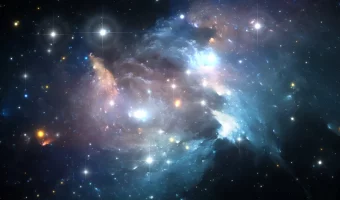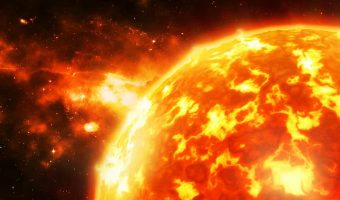
From Birth to Death: The Lifecycle of Our Sun
Last Updated: January 30 2023
The Sun has been humanity’s constant companion since the beginning, seemingly immortal, but just like all things, including us, the Sun was born and will die.
Let’s tell the story of the lifecycle of our sun, a tale ranging billions and even trillions of years.
Introduction
When discussing things that tend to stay the same over great periods of time, the Sun often comes to mind. We see it rise and set every day, and have seen it do so for as long as humanity has been around. Even when bad weather blocks the Sun, we see it return once the storms have passed. Even when the Moon appears to block the sun, creating darkness in the middle of the day, the sun returns once the Moon passes.
And the importance of the Sun isn’t limited by simply its constant presence. It’s the biggest thing in the solar system and is often referred to as the mother of our solar system family as it provides warmth and light as well as keeps us close due to its gravitational pull, keeping us from drifting away into empty space.
So, we’ve continued to study the Sun over thousands of years as well as its sisters out in the night sky. What is the life of our Sun? When and how was it born? At what point in its lifecycle is it currently? How and when will it die?
The birth of the Sun
Stars are formed in clouds of gas and dust called nebulae or stellar nurseries which can form anywhere between a few dozen to thousands of stars. Approximately 4.5 billion years ago, a cloud of gas and dust a hundred times the size of our solar system began to collapse.
As particles of dust were attracted to each other, blobs or knots of gas and dust began to form and spin around each other. Once they had enough mass and speed, they began to collapse in on themselves and therefore heat up at the center as pressure increased, creating a ball at the center with most of the mass and a disc of the rest of the material rotating around it.
This hot ball, the core, was a protostar, waiting to begin life as a star. The sun spent about 100,000 years as a collapsing protostar. A star is born once the hot core at the center becomes heavy and hot enough for hydrogen atoms to overcome their natural repulsive tendencies and fuse together into one Helium atom.
After nuclear fusion occurred, the Sun started as a wildly active and violent star with immense solar wind known as a T Tauri star for a few million years, giving the Sun time to become stable and enter the main sequence stage. The remaining dust in the disc around the core became other parts of the solar system, such as planets, asteroids, and comets, but some also just remained as dust.

The different layers that make up the Sun.
The main sequence phase
Today, approximately 4.5 billion years later, the Sun is still in the main sequence phase of its lifecycle, fusing hydrogen atoms together into helium to produce energy in the form of radiation including primarily heat and light.
Our Sun, like other Yellow or Orange stars, is fairly average in size, temperature, and luminosity. The Sun isn’t particularly large, hot, or bright, but it isn’t particularly small, cool, or dim. It is a medium, average, or you might even say it’s a “Goldilocks” star, just right.
Related article: How hot is the Sun?
To date, the Sun is composed of more than 72% hydrogen. It has converted about enough hydrogen as 100 times the mass of Earth into helium and solar energy over its 4.5-billion-year life span and will continue in its main sequence phase for about another 5-6 billion years.
As it continues to use the fuel, it will slowly shrink to maintain balance, which causes the fusion process to speed up and luminosity to increase at a rate of 1% every 100 million years. In about 1.1 billion years, the Sun will be 10% brighter than today, which will also mean an increase in heat, which the Earth’s atmosphere will absorb, triggering a moist greenhouse effect similar to the warming that occurred on Venus.
The end of the main sequence phase
Since there is a finite amount of hydrogen within the Sun’s core, it will eventually run out. A star’s life is generally dictated by how massive it is, how much potential energy it has based on the amount of Hydrogen in its core. In general, the larger a star is, the shorter its life will be, though billions of years is a typical lifetime for all but the most massive stars.
In about 5.4 to 6.4 billion years, the Sun will run out of hydrogen, ending its main sequence phase, and causing drastic changes to the sun and the solar system.

The red giant phase
As hydrogen is fused to make helium, the Sun’s supply of hydrogen dwindles. The Sun becomes heavier making it harder for it to maintain the balance crucial to being a star. The core begins to collapse in on itself, increasing temperature, and then fusing what hydrogen is left outside the core into a shell.
The outer layers of the sun push outward, causing it to expand and cool into a red giant, encompassing the orbits of Mercury, Venus, and maybe even Earth. Again, between the already increasing temperatures from the Sun in the latter end of its main sequence phase, and the expansion of the Sun into a red giant, life will not be able to survive on Earth, turning it similar to present-day Venus if it has not been swallowed up by the sun.
After about 1 billion years as a red giant, the core will ignite violently in a helium flash, where massive amounts of helium will be converted into carbon within minutes. The Sun will shrink to about 10 times its size today and 50 times its current luminosity, but slightly cooler than today.
It will then expand again and become more luminous for the next 20 million years as it becomes increasingly unstable. It will begin losing mass due to a series of thermal pulses/ bursts of radiation that shed layers of mass every 100,000 years, ultimately increasing its luminosity to 5,000 times its current state and its radius to over 1 AU (the orbit of Earth). After another 500,000 years, only half of the sun’s current mass will remain and its outer envelope will form a planetary nebula of gas and dust.

The white dwarf phase
Eventually, the naked core will reach 100,000 degrees Kelvin, but will slowly cool over about 10,000 years as the planetary nebula disperses, leaving behind a white dwarf, essentially an immensely hot cinder of the stellar fire it was, made up mostly of carbon and oxygen.
White Dwarfs are about the size of Earth, but contain the mass of a star meaning even a teaspoon of it could weigh about 5.5 tons, as much as an elephant. They are very faint because they are so small and since they no longer have an active nuclear reaction, they will slowly cool down over trillions of years and fade away to what is called a black dwarf.
Conclusion
While seemingly eternal, the Sun is a giant ball of burning gas currently 4.5 billion years old that will continue for about 8 billion more before slowly fading away. It was born out of the gas and dust of previous stars, collecting mass until nuclear fusion could ignite, creating the core.
The Sun then continued fusing hydrogen into helium, creating energy that gives us heat and light as well as being massive enough to hold us all together in our solar system. It will continue to do so for about another 5 billion years when it will use up its store of hydrogen and begin fusing heavier elements, disrupting the balance of its structure. It will then expand into a red giant, consuming Mercury, Venus, and potentially even Earth. It will continue fusing heavier and heavier elements, spewing layers into a planetary nova until it can no longer maintain a balance and the core ultimately collapses, leaving behind a White Dwarf which will slowly fade away.
While not as exciting as a supernova or a black hole, there is something poetic about the fact the Sun will continue in one way or another for trillions of years and we will continue to study our star and others to better understand their processes.
Check out our previous article if you would like to learn more about how stars are made and the process of solar formation including the differences in the lifecycle of larger stars.

Sarah Hoffschwelle is a freelance writer who covers a combination of topics including astronomy, general science and STEM, self-development, art, and societal commentary. In the past, Sarah worked in educational nonprofits providing free-choice learning experiences for audiences ages 2-99. As a lifelong space nerd, she loves sharing the universe with others through her words. She currently writes on Medium at https://medium.com/@sarah-marie and authors self-help and children’s books.
Wow! There's more to read 🚀
This page is part of our collection of articles about astronomy. If you enjoyed the read, then you’ll love the following articles.


Stars are the fundamental building blocks of the universe and are responsible for creating most of the elements. What are they made of?

While there are ~1024 stars in the universe, there are less than 20 types of stars. In this article, we’ll explore star types.

Our Sun is not a particularly large star. In fact, the universe is home to many celestial behemoths. Let’s take a look at some of the largest known stars.
